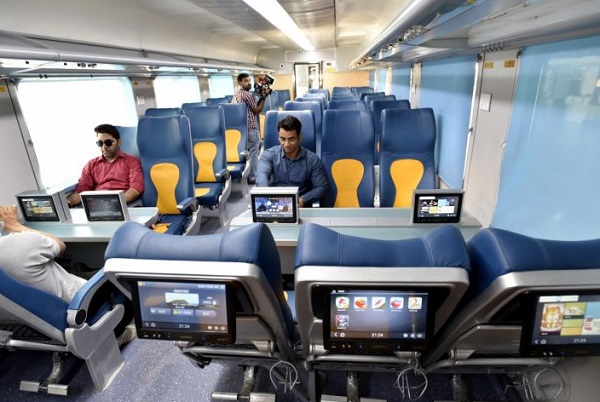Earlier today (30 April), the final report of the task force for the National Infrastructure Pipeline was released. Focussing on many sectors, the report puts the infrastructure expenditure between financial year (FY) 2020 and FY2025 at more than Rs 11,430,428 crore.
Of the total amount, Rs 1,367,563 crore has been earmarked for the Indian Railways, one of the most critical sectors of the Indian economy.
Of the total capital expenditure planned for the railways, only Rs 8,743 crore is going to come from the state governments. About 724 identified projects will be implemented in this period. Of the 724 projects, 697 projects worth Rs 11.97 lakh crore will be implemented under the EPC (engineering, procurement and construction) model while 27 projects will be implemented through the public-private partnership (PPP) model.
Around 259 projects worth Rs 440,072 crore will be focused on new lines and gauge conversion. At least 266 projects worth Rs 247,985 crore will be for capacity augmentation. Thirty-one projects worth Rs 275,539 crore will be for rolling stock, and 159 other projects worth Rs 118,406 crore form a part of the plan.
The Dedicated Freight Corridor (DFC) project, starting with the Eastern and Western corridors, will see a capital expenditure of Rs 166,171 crore in seven projects. Two high-speed rail projects, including the Mumbai-Ahmedabad bullet train project, have also been included at a cost of Rs 110,647 crore.
According to the report, the Indian Railways has been investing significantly to enhance safety, augment the speed of trains, improve freight efficiency, and enhance passenger amenities and safety while ensuring better connectivity.
The report also highlights the investments made in this sector post-2016, the focus areas being decongestion of over utilised railway network, construction of new lines, doubling, tripling, and quadrupling of rail lines and purchasing of rolling stock, which includes wagons, locomotives and coaches.
While FY2013 saw an investment of Rs 0.4 lakh crore in the railways sector, the investment increased to Rs 0.8 lakh crore in FY2016, Rs 0.9 lakh crore in FY2017, Rs 1.3 lakh crore in FY18E (E for estimate) and around Rs 1.4 lakh crore in FY19E (the report gives estimate figures for FY2018 and FY2019). The investment in railways as a percentage of the total infrastructure investment increased from 8 per cent in FY2013 to 14 per cent in FY2019E.
For fiscal 2018, the gross revenue receipts of the Indian Railways was Rs 1.78 lakh crore, growing at 6 per cent CAGR (compound annual growth rate).
However, the operating ratio increased from 91 per cent in FY2015 to 98 per cent in FY2018 due to an increase in operating expenses due to the implementation of sixth and seventh pay commissions and declining share in freight traffic. The high operating ratio has been a hindrance for the railways in making fresh investments.
The gross revenue receipts of the railways, however, steadily increased from Rs 1.4 lakh crore in FY2014 to Rs 1.7 lakh crore in FY2016 to Rs 1.8 lakh crore in FY2018.
The upward trends in passenger and freight traffic have not been upto the mark, if the numbers in the report are any indicator. From 8,397 million passengers in FY2014, the number has declined to 8,286 million in FY2018, signalling the importance of airlines in India’s transport sector.
Even the freight traffic has not seen much of an upward trend, given railways transported 1,160 million tonnes worth of freight in FY2018 against 1,008 million tonnes in FY2014.
The passenger earnings have been on the rise, however. While in FY2014, the railways made around Rs 91,000 crore from passengers alone, the figure increased to nearly Rs 113,000 crore in FY2018.
For freight, the earnings increased from about Rs 36,500 crore to Rs 48,600 crore in FY2018. This jump in freight earnings highlights the potential of the DFC project in the long run. In 2019, the railways carried 1,221 million tonnes worth of freight.
However, increased investments in the railways are warranted given the deficiency in the previous years has led to stagnancy in route extension.
Between FY2014 and FY2018, only 2,634 km of additional route was constructed, taking the total to 68,442 kms. The good news is that the number of rail accidents has come to 72 in 2018 from 131 in 2015.
However, plenty of challenges hinder the railways sector in India. These include lack of investment in capacity augmentation, lack of rake availability for cargo movement, losing passenger share to airlines, passenger traffic crowding out freight traffic, the lack of independent regulation of passenger and freight fares, need for station redevelopment, and slow progress on improving the operating ratio.
The document also outlines the ‘Vision 2025’ for the railways sector.
Firstly, on the freight front. The capex (capital expenditure) aims to increase the share of Indian Railways in freight traffic from 33 per cent now to 40 per cent. This will be done through the DFC project.
By 2025, the government aims to have eastern and western DFCs functional, along with the Mumbai-Ahmedabad high-speed rail project.
Two, there is also scope for increased privatisation in the railways by 2025. As per the report, the government vision includes privatisation of 30 per cent of the net cargo volumes and 500 passenger trains, along with privatising 30 per cent of the 750 stations.
Three, electrification of the existing railway network while ensuring operational efficiency by means of optimum usage and doubling, tripling, and quadrupling of sections of high-density corridors. This would ensure there are less train delays, faster movement of freight, and a highly utilised network.
Thus, under these circumstances, major investments in the sector will be critical. Given investments in railways alone constitute for around 10 per cent of the total investments in the national infrastructure pipeline, it will be interesting to see if Narendra Modi 2.0 is indeed able to give railways the revamp it desperately needs.


